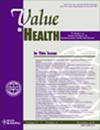Cost-Effectiveness of a Digitally Supported Care Management Program for Caregivers of People With Dementia
IF 4.9
2区 医学
Q1 ECONOMICS
引用次数: 0
Abstract
Objectives
To examine the cost-effectiveness of a digitally supported care management system (CMS) for caregivers of people with dementia (PwD) compared with usual care.
Methods
The analysis was based on 192 caregivers (n = 96 CMS, n = 96 usual care) of PwD in a cluster-randomized controlled trial testing a digitally supported CMS, aiming to identify and address caregivers’ unmet needs and develop and implement an individualized support and care plan over 6 months. Incremental costs from the public-payer and societal perspectives, quality-adjusted life years (QALY), and the incremental cost-effectiveness ratio 6 months after baseline were calculated using multivariate regression models. We assessed the probability of cost-effectiveness using a range of willingness-to-pay thresholds.
Results
Caregivers in the intervention group gained QALYs (+0.004 [95% CI −0.003 to 0.012], P value = .225) and had lower costs from the public payer (−378€ [1926-1168], P value = .630), but higher costs from the societal perspective (+1324 [−3634 to 6284], P value = .599). The intervention dominated usual care from the payer perspective, whereas the incremental cost-effectiveness ratio was €331 000/QALY from a societal perspective. The probability of cost-effectiveness was 72% and 79% from the public payer and 33% and 35% from a societal perspective at the willingness-to-pay thresholds threshold of €40 000 and €80 000/QALY gained.
Conclusions
CMS was likely cost-effective from the payer but not from a societal perspective, underlining the importance of informal care. The gain in QALY was marginal and could be due to the short observation period. Focusing on both the caregiver and the PwD, rather than assessing the PwD needs through the caregiver, could improve the cost-effectiveness results.
求助全文
约1分钟内获得全文
求助全文
来源期刊

Value in Health
医学-卫生保健
CiteScore
6.90
自引率
6.70%
发文量
3064
审稿时长
3-8 weeks
期刊介绍:
Value in Health contains original research articles for pharmacoeconomics, health economics, and outcomes research (clinical, economic, and patient-reported outcomes/preference-based research), as well as conceptual and health policy articles that provide valuable information for health care decision-makers as well as the research community. As the official journal of ISPOR, Value in Health provides a forum for researchers, as well as health care decision-makers to translate outcomes research into health care decisions.
 求助内容:
求助内容: 应助结果提醒方式:
应助结果提醒方式:


